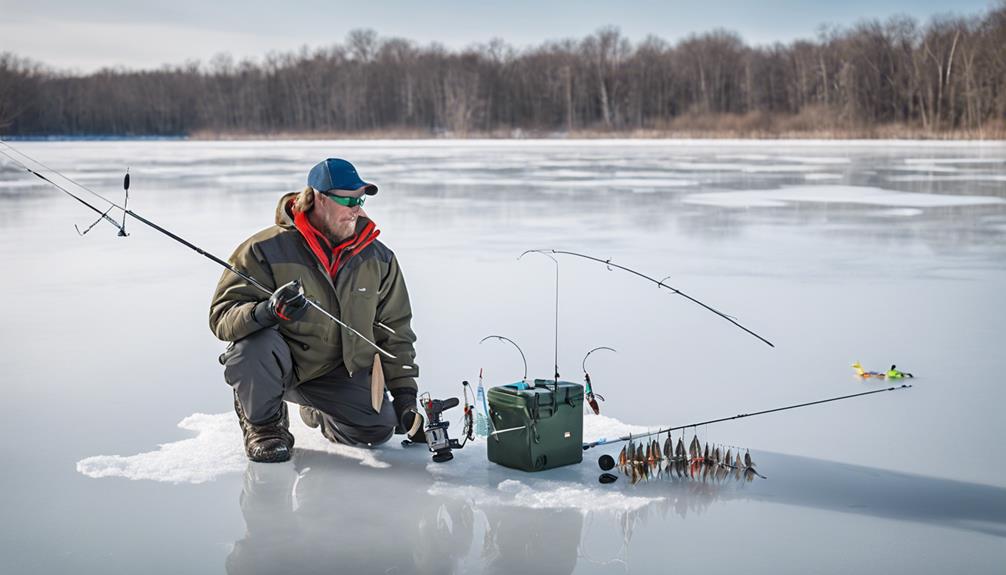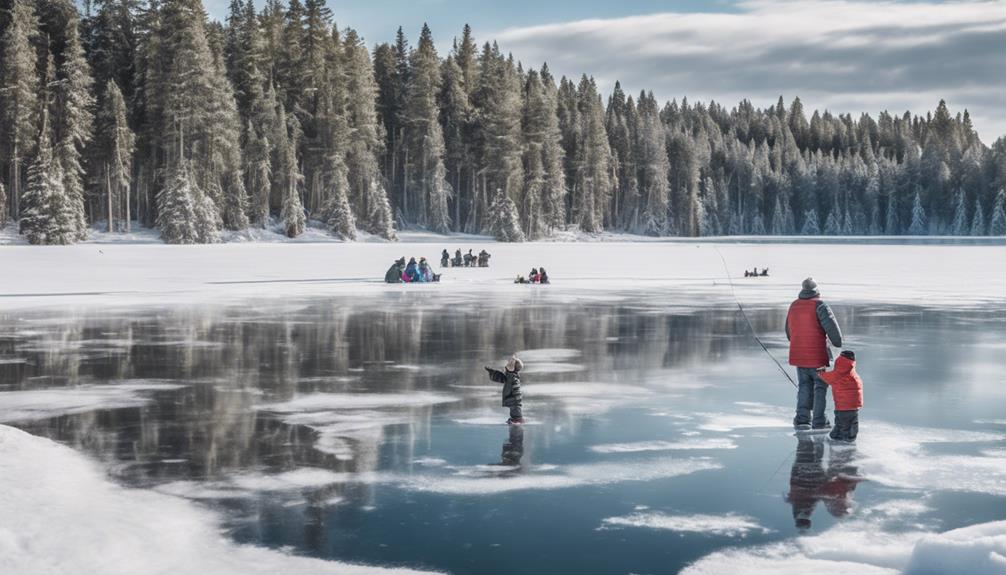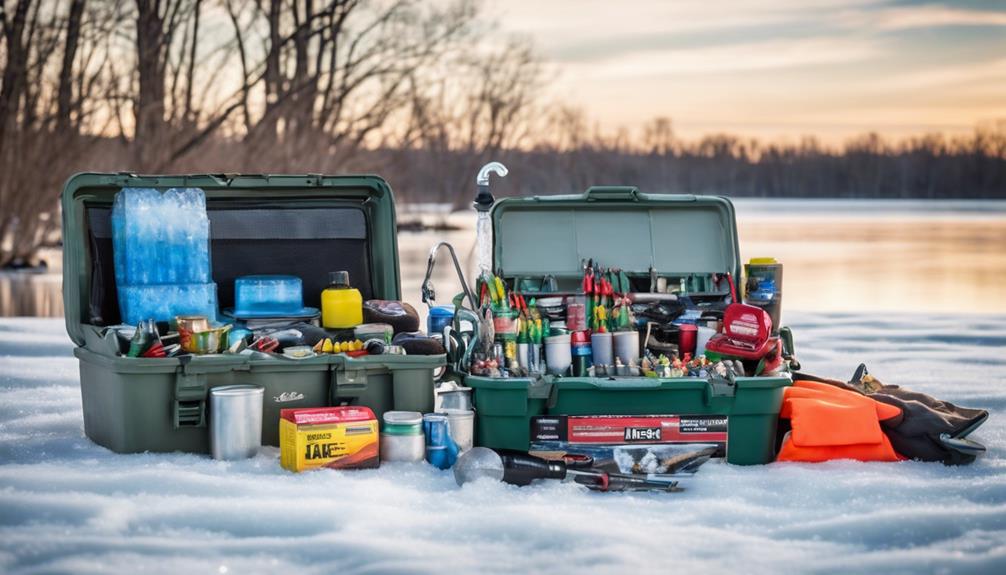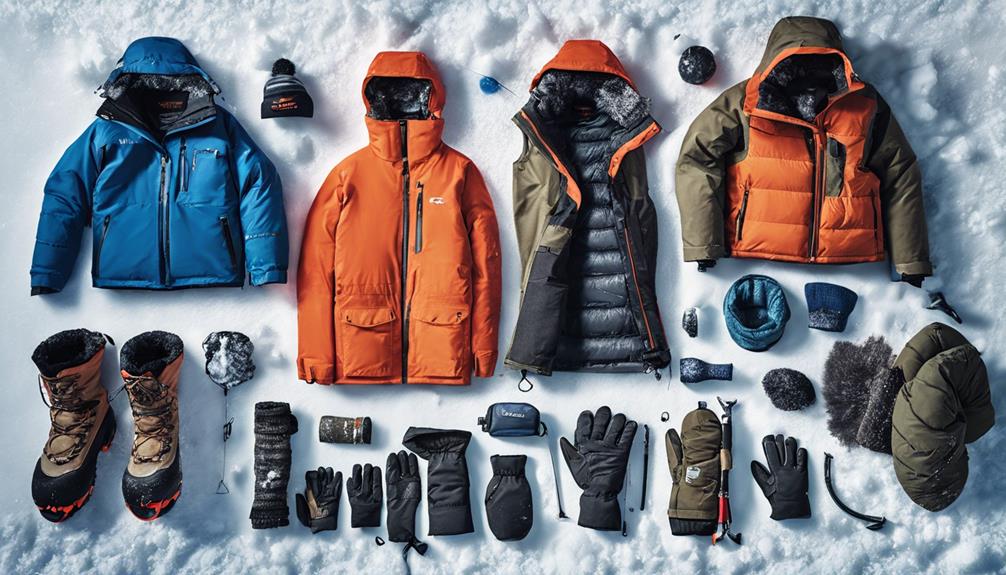When it comes to pike ice fishing, imagine your strategies as tools in a well-stocked tackle box, each one ready to help you reel in success. From selecting the right gear to honing your technique, mastering these tactics is essential.
But what if there was a hidden key that could unlock even greater success on the ice? Stay tuned to discover a crucial aspect that might just be the game-changer you need for a truly triumphant pike fishing expedition.
Choosing the Right Equipment
When gearing up for pike ice fishing, ensure you select the right equipment to maximize your chances of a successful catch. Proper gear selection and equipment maintenance are crucial for a productive ice fishing trip. Begin by inspecting your ice fishing gear before each outing. Check your ice auger to ensure it's in good working condition and sharp enough to drill through the ice efficiently. A dull auger can make drilling holes a tiresome task. Additionally, inspect your ice fishing rods and reels for any damage or wear. Replace any worn-out line to prevent break-offs when battling pike.
When it comes to gear selection, choosing the right rod is essential. Opt for a medium to medium-heavy action rod around 30-36 inches long to provide the necessary strength to handle large pike. Pair this with a quality reel that can withstand harsh winter conditions. Spool your reel with a strong and abrasion-resistant line, like braided line, to handle the sharp teeth of pike. Don't forget to pack a variety of lures in different sizes and colors to adapt to changing conditions and pike preferences.
Regular equipment maintenance is key to ensuring your gear performs optimally. After each trip, clean your gear thoroughly to prevent rust and damage. Store your equipment properly in a dry place to prolong its lifespan. By selecting the right gear and maintaining it well, you set yourself up for a successful pike ice fishing adventure.
Locating the Best Spots
Inspecting your ice fishing gear before heading out is crucial, and once you're prepared with the right equipment, the next step is locating the best spots for a successful pike ice fishing expedition. To begin, consider depth exploration as pike tend to prefer certain water depths during different times of the day. Using mapping technology and sonar devices can significantly aid in this process.
When looking for potential fishing spots, focus on underwater structures such as submerged vegetation, drop-offs, and rocky areas. These are prime locations where pike like to lurk, waiting for their next meal. Pay attention to any irregularities in the underwater terrain as these spots can often hold a higher concentration of fish.
Mapping technology, such as GPS units or fish finders equipped with sonar capabilities, can help you identify these underwater structures more effectively. By utilizing these tools, you can create a detailed map of the area, marking key spots that are worth exploring further.
Once you have located promising areas with the right depth and underwater structures, set up your ice fishing gear and start drilling holes. Remember, pike are known to be ambush predators, so positioning your bait near these structures can increase your chances of a successful catch. By combining your knowledge of depth exploration and underwater structures with the use of mapping technology and sonar devices, you'll be well on your way to finding the best spots for pike ice fishing.
Understanding Pike Behavior
To understand pike behavior effectively, observe their movements and feeding patterns in different environmental conditions. Pike have distinct breeding habits that influence their behavior. During the breeding season in early spring, pike are more active and aggressive as they search for suitable spawning grounds. Understanding this behavior can help you anticipate where pike may be located and increase your chances of a successful catch.
Feeding patterns also play a crucial role in understanding pike behavior. Pike are opportunistic predators, often lurking in weed beds or near structures to ambush their prey. They prefer to feed during low light conditions or under the cover of vegetation. By recognizing these feeding habits, you can strategically place your bait in areas where pike are likely to be hunting.
Pike behavior can vary based on factors such as water temperature, time of day, and seasonal changes. In colder water temperatures, pike tend to be less active and may require slower presentation techniques to entice a bite. Conversely, in warmer water, pike may be more aggressive and willing to chase down fast-moving lures.
Using the Correct Bait
Choosing the right bait is essential for successful pike ice fishing trips. When it comes to bait selection, presentation is key. To increase your catch rates and overall success rates, consider the following tips:
- Variety is Key: Pike can be picky, so having a variety of bait options is crucial. Experiment with different types of bait such as dead bait, live bait, or lures to see what works best on any given day.
- Size Matters: When selecting bait for pike fishing, size matters. Larger baits tend to attract bigger pike, while smaller baits may be more effective for smaller pike. Adjust your bait size based on the size of pike you're targeting.
- Consider the Environment: Pay attention to the water conditions and the behavior of the pike in that specific area. Match your bait selection to the environment. For example, if the water is clear and the pike are more active, using a brightly colored lure may be more effective in catching their attention.
Mastering the Jigging Technique
When mastering the jigging technique for pike ice fishing, your movements and timing are crucial for enticing strikes. Pike are known to be aggressive predators, so using the right jigging variations and technique tips can greatly increase your chances of success on the ice.
Experimenting with different jigging variations is essential to find what works best on any given day. Try mixing up your jigging motion by incorporating short, sharp jerks to mimic wounded prey or slower, more subtle movements to entice cautious pike. Pay attention to how the fish are responding and adjust your technique accordingly.
To improve your jigging technique, focus on using your wrist rather than your entire arm to create more precise and controlled movements. Keep your movements erratic and unpredictable to grab the attention of nearby pike. Vary the depth at which you jig to cover more water and increase your chances of attracting fish.
Remember to stay observant of your surroundings and be patient. It may take some time to dial in the perfect jigging technique for the day, but persistence is key. By mastering different jigging variations and technique tips, you'll be well on your way to a successful pike ice fishing adventure.
Staying Patient and Persistent
Being patient and persistent is key to achieving success in pike ice fishing. When you're out on the ice, remember to maintain focus on your goal and manage your expectations realistically. Here are some tips to help you stay patient and persistent:
- Stay Mentally Strong: Pike ice fishing can sometimes require long hours without immediate results. Remind yourself to stay focused on the task at hand and avoid getting discouraged if the bites are slow.
- Adapt Your Approach: Sometimes pike can be finicky, and it may take time to figure out what they're biting on. Be persistent in trying different lures and techniques until you find what works.
- Celebrate Small Wins: Even if you're not landing the trophy pike right away, celebrate the small victories along the way. Whether it's successfully jigging in a new spot or feeling a strong bite, acknowledging these moments can help keep you motivated.
Adapting to Changing Conditions
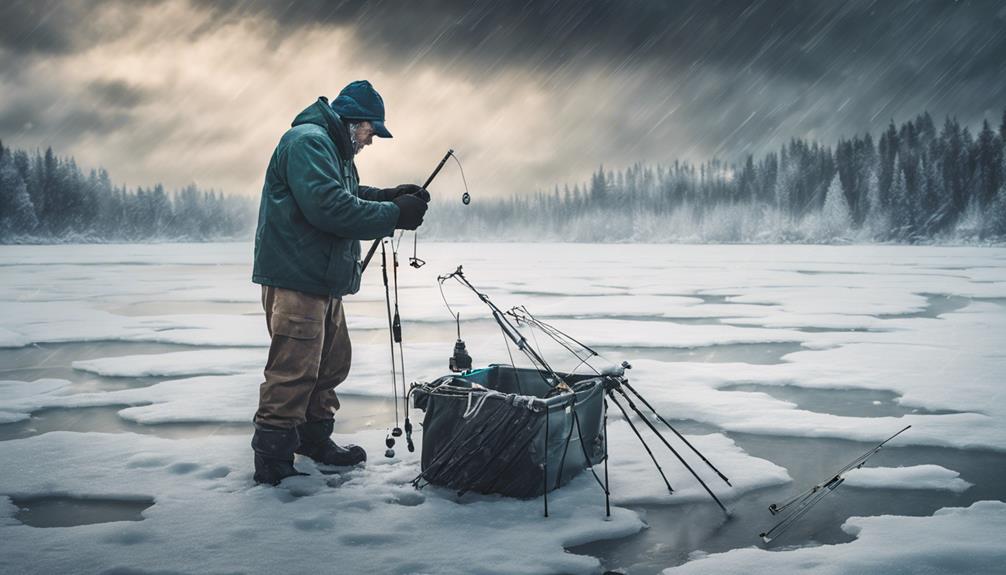
To excel in pike ice fishing, it's crucial to adapt effectively to changing environmental conditions. When out on the ice, one of the key elements to consider is your ice shelter. Having a portable ice shelter can provide protection from harsh weather conditions like wind and snow. Being able to move your shelter easily will allow you to relocate swiftly in response to changing fishing conditions such as the movement of the fish or shifts in weather patterns.
In addition to your shelter, keeping an eye on weather predictions is essential for adapting your fishing strategy. Weather forecasts can give you valuable insights into upcoming changes in temperature, wind speed, and precipitation. By staying informed about the weather, you can anticipate when it might be time to move to a new spot, change your bait selection, or adjust your fishing techniques accordingly.
Practicing Safety Measures
Ensuring safety while ice fishing for pike requires diligent preparation and adherence to essential guidelines. When venturing out onto the frozen waters, keep these key safety measures in mind:
- Emergency Preparedness: Before heading out, inform someone of your plans, including your expected return time. Carry a fully charged cell phone in a waterproof bag and consider bringing along a portable GPS device. Pack a first aid kit, a whistle, and a multi-tool in case of emergencies.
- Proper Attire: Dressing appropriately for the cold conditions is crucial. Wear thermal layers to keep warm and dry, including moisture-wicking materials close to your skin. Insulated, waterproof outerwear is essential to protect against wind and wetness. Don't forget insulated gloves, a warm hat, and waterproof boots with good traction to prevent slips on the ice.
- Ice Safety: Always check the ice thickness before setting out. Clear, hard ice should be at least 4 inches thick for safe fishing, while 5-6 inches are needed for groups. Avoid areas with cracks, moving water, or partially melted ice. Carry ice picks or spikes around your neck in case you need to pull yourself out of the water in an emergency.
Frequently Asked Questions
How Can I Tell if the Ice Is Safe Enough for Pike Ice Fishing?
Before stepping onto the ice for pike ice fishing, ensure safety first. Check the ice thickness by using an auger to drill holes and measure. A safe thickness is at least 4 inches for fishing alone and 5-6 inches for groups.
Look for clear ice, not slushy or white. Test the ice condition continuously as you move. Remember to wear a life jacket, carry ice picks, and fish with a buddy for added safety precautions.
What Time of Day Is Best for Catching Pike Through the Ice?
To catch pike through the ice, consider fishing during early morning or late afternoon. These times are ideal as pike are more active then.
Pay attention to moon phases and weather patterns, as they can affect fish behavior. By timing your ice fishing trips accordingly, you may increase your chances of landing a big pike.
Are There Any Special Techniques for Setting the Hook When Ice Fishing for Pike?
When ice fishing for pike, mastering hook setting technique is crucial.
Due to pike's aggressive nature, a quick and firm hook set is key to landing these fish.
Make sure to set the hook with a swift upward motion to ensure it penetrates the pike's bony mouth.
Practice your technique to increase your chances of a successful hook set and landing that prized pike.
How Do I Properly Release a Pike After Catching It Through the Ice?
When releasing a pike after catching it through the ice, proper handling is crucial for conservation. Remember, catch and release practices are essential for the ethics of fishing.
To release a pike properly, support its body horizontally, avoid touching the gills, and use a gentle grip. Minimize the time out of the water and release the fish back into the water gently.
These practices help ensure the pike's survival and promote sustainable fishing.
Can I Use Live Bait When Ice Fishing for Pike, or Is Artificial Bait More Effective?
When ice fishing for pike, using live bait can be effective, but artificial bait is also a great option. Consider ice thickness and safety when choosing your bait.
Live bait can sometimes attract bigger pike, but artificial bait can be more convenient and easier to manage. Experiment with both to see what works best for you and always prioritize safety on the ice.
Conclusion
So there you have it, with the right equipment, knowledge of pike behavior, and patience, you're well on your way to successful pike ice fishing.
Remember to locate the best spots, use the correct bait, master jigging techniques, and adapt to changing conditions.
Stay safe on the ice and always be persistent in your efforts.
With these strategies in mind, you'll have a great chance at reeling in some big pike on your next ice fishing adventure.
Happy fishing!
